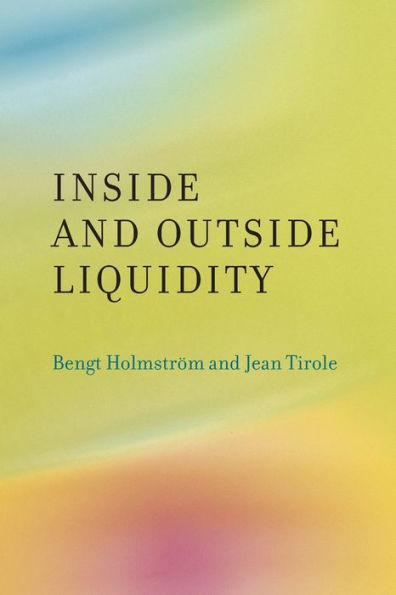

Paperback(Reprint)
-
PICK UP IN STORECheck Availability at Nearby Stores
Available within 2 business hours
Related collections and offers
Overview
Why do financial institutions, industrial companies, and households hold low-yielding money balances, Treasury bills, and other liquid assets? When and to what extent can the state and international financial markets make up for a shortage of liquid assets, allowing agents to save and share risk more effectively? These questions are at the center of all financial crises, including the current global one.
In Inside and Outside Liquidity, leading economists Bengt Holmström and Jean Tirole offer an original, unified perspective on these questions. In a slight, but important, departure from the standard theory of finance, they show how imperfect pledgeability of corporate income leads to a demand for as well as a shortage of liquidity with interesting implications for the pricing of assets, investment decisions, and liquidity management. The government has an active role to play in improving risk-sharing between consumers with limited commitment power and firms dealing with the high costs of potential liquidity shortages. In this perspective, private risk-sharing is always imperfect and may lead to financial crises that can be alleviated through government interventions.

Product Details
| ISBN-13: | 9780262518536 |
|---|---|
| Publisher: | MIT Press |
| Publication date: | 01/11/2013 |
| Series: | The MIT Press |
| Edition description: | Reprint |
| Pages: | 262 |
| Product dimensions: | 8.80(w) x 5.90(h) x 0.60(d) |
| Age Range: | 18 Years |
About the Author
Jean Tirole, the 2014 Nobel Laureate in Economics, is Scientific Director of IDEI (Institut d'Economie Industrielle), Chairman of the Board of TSE (Toulouse School of Economics), and Annual Visiting Professor of Economics at MIT.
Table of Contents
Acknowledgments vii
Prologue: Motivation and Roadmap 1
I Basics of Leverage and Liquidity 9
1 Leverage 15
2 A Simple Model of Liquidity Demand 27
II Complete Markets 61
3 Aggregate Liquidity Shortages and Liquidity Premia 65
4 A Liquidity Asset Pricing Model (LAPM) 89
III Public Provision of Liquidity 115
5 Public Provision of Liquidity in a Closed Economy 121
6 Liquidity Provision with Access to Global Capital Markets 145
IV Waste of Liquidity and Public Policy 165
7 Financial Muscle and Overhoarding of Liquidity 169
8 Specialized Inputs and Secondary Markets 199
Epilogue: Summary and Concluding Thoughts on the Subprime Crisis 227
Bibliography 243
Index 251
What People are Saying About This
The Holmström-Tirole view of liquidity creation, pricing, and management has had a profound impact on a wide variety of fields, ranging from macroeconomics to corporate finance. This book is assured to become an instant classic.
This is a very insightful book on a difficult and poorly understood topic at the center of the current financial crisis. It benefits from a unified approach, based on incentive theory, that delivers a coherent perspective on the elusive concept of liquidity.
This is a very insightful book on a difficult and poorly understood topic at the center of the current financial crisis. It benefits from a unified approach, based on incentive theory, that delivers a coherent perspective on the elusive concept of liquidity.—Xavier Vives, IESE Business School, Barcelon
"In this excellent book, Holmstrom and Tirole put together a unified theory of liquidity, with applications ranging from the impact of liquidity on asset prices to the liquidity enhancing role of government debt, and the importance of international liquidity. In addition to academics and students of economics, it will appeal to people who work at central banks and international organizations. It is an important contribution." Franklin Allen , Nippon Life Professor of Finance and Professor of Economics, The Wharton School, University of Pennsylvania
"The Holmström-Tirole view of liquidity creation, pricing, and management has had a profound impact on a wide variety of fields, ranging from macroeconomics to corporate finance. This book is assured to become an instant classic." Ricardo Caballero , Ford International Professor of Economics,MIT
"The policy discussions surrounding the recent financial turmoil highlight our crucial need for a unified theoretical framework within which to analyze the asset price impact of liquidity, its macroeconomic consequences, and the role of government intervention. This book simultaneously answers these three questions and is a landmark contribution. It is likely to inspire much subsequent research in both macroeconomics and finance." Pierre-Olivier Weill , UCLA
"This is a very insightful book on a difficult and poorly understood topic at the center of the current financial crisis. It benefits from a unified approach, based on incentive theory, that delivers a coherent perspective on the elusive concept of liquidity." Xavier Vives , IESE Business School, Barcelona
In this excellent book, Holmstrom and Tirole put together a unified theory of liquidity, with applications ranging from the impact of liquidity on asset prices to the liquidity enhancing role of government debt, and the importance of international liquidity. In addition to academics and students of economics, it will appeal to people who work at central banks and international organizations. It is an important contribution.
The policy discussions surrounding the recent financial turmoil highlight our crucial need for a unified theoretical framework within which to analyze the asset price impact of liquidity, its macroeconomic consequences, and the role of government intervention. This book simultaneously answers these three questions and is a landmark contribution. It is likely to inspire much subsequent research in both macroeconomics and finance.
